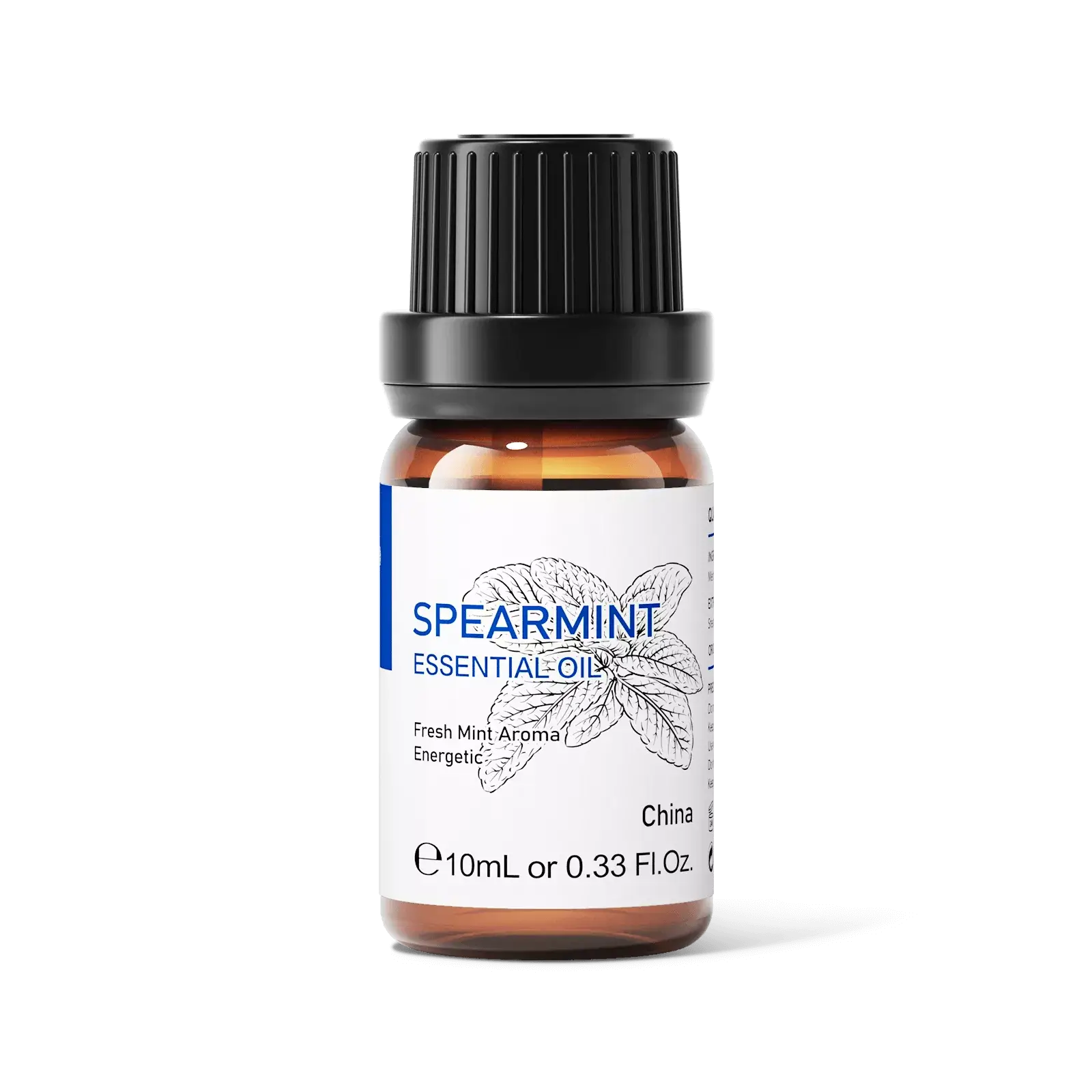
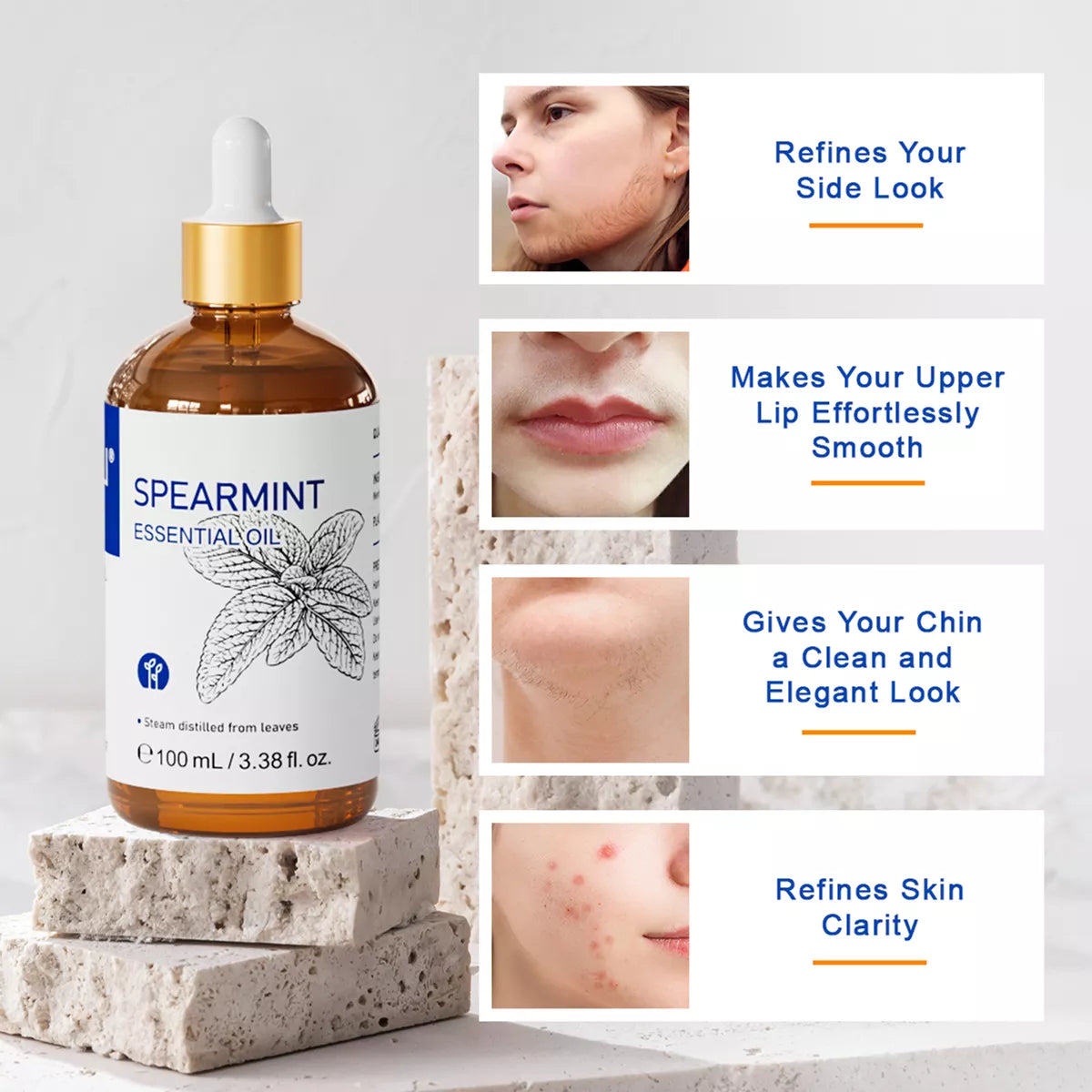
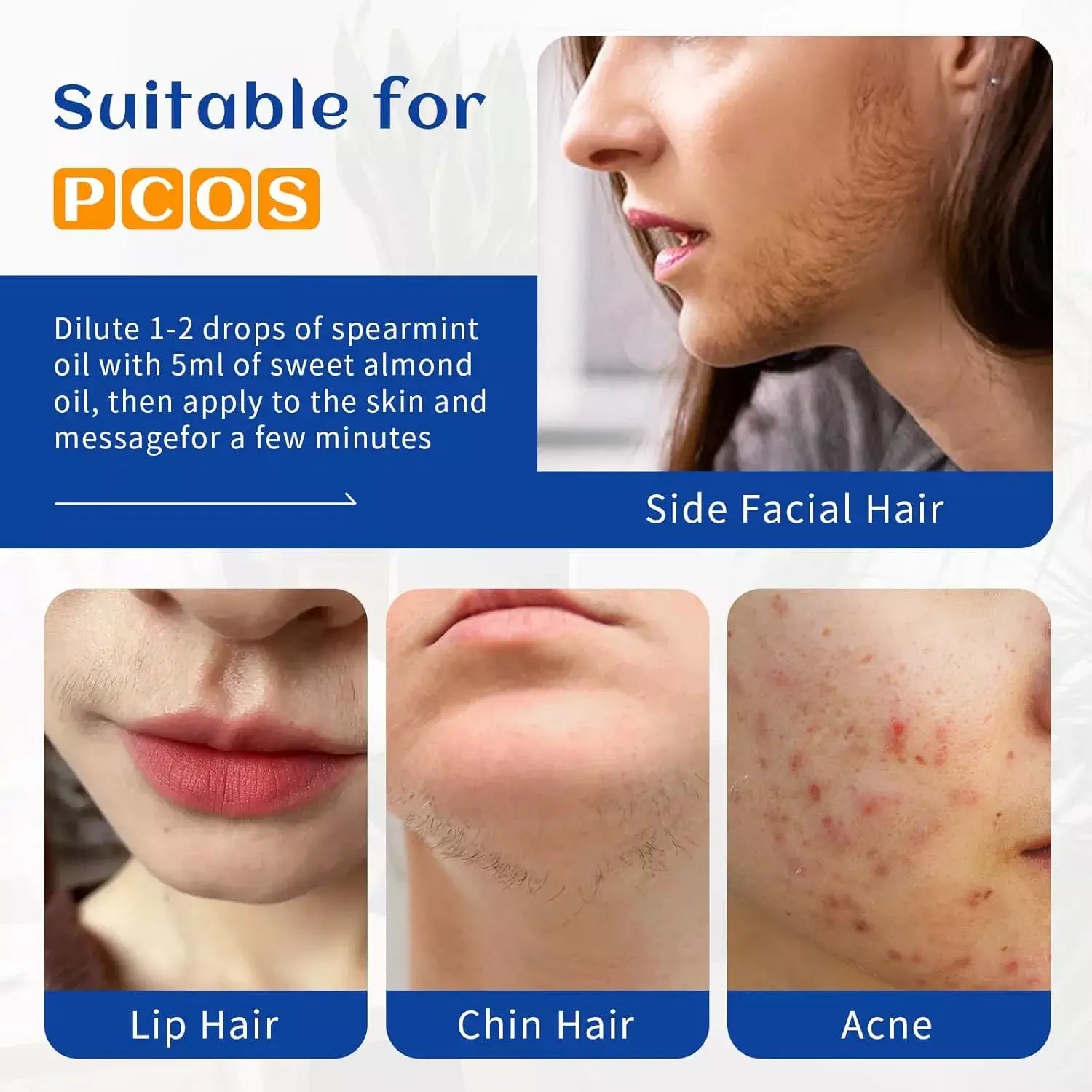
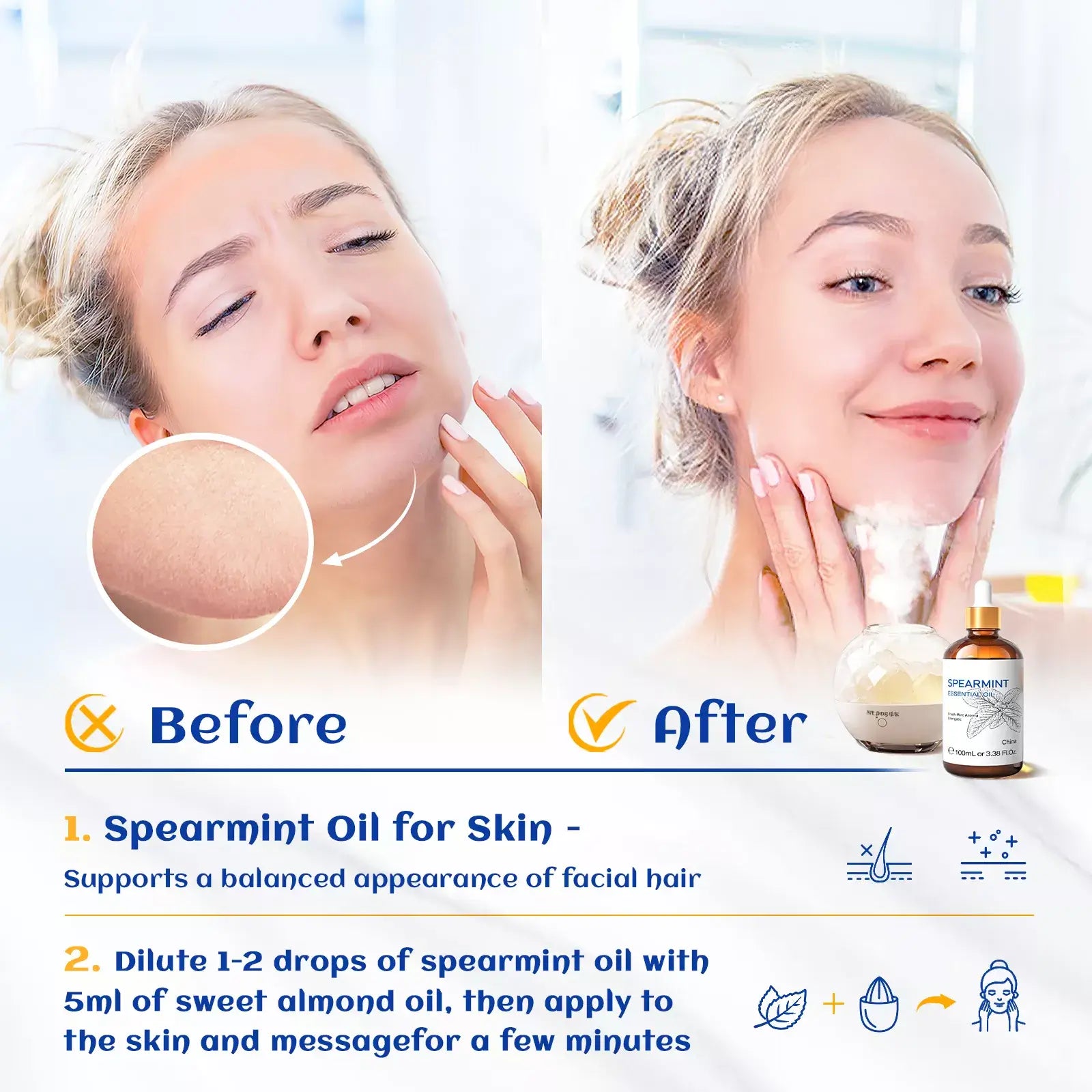
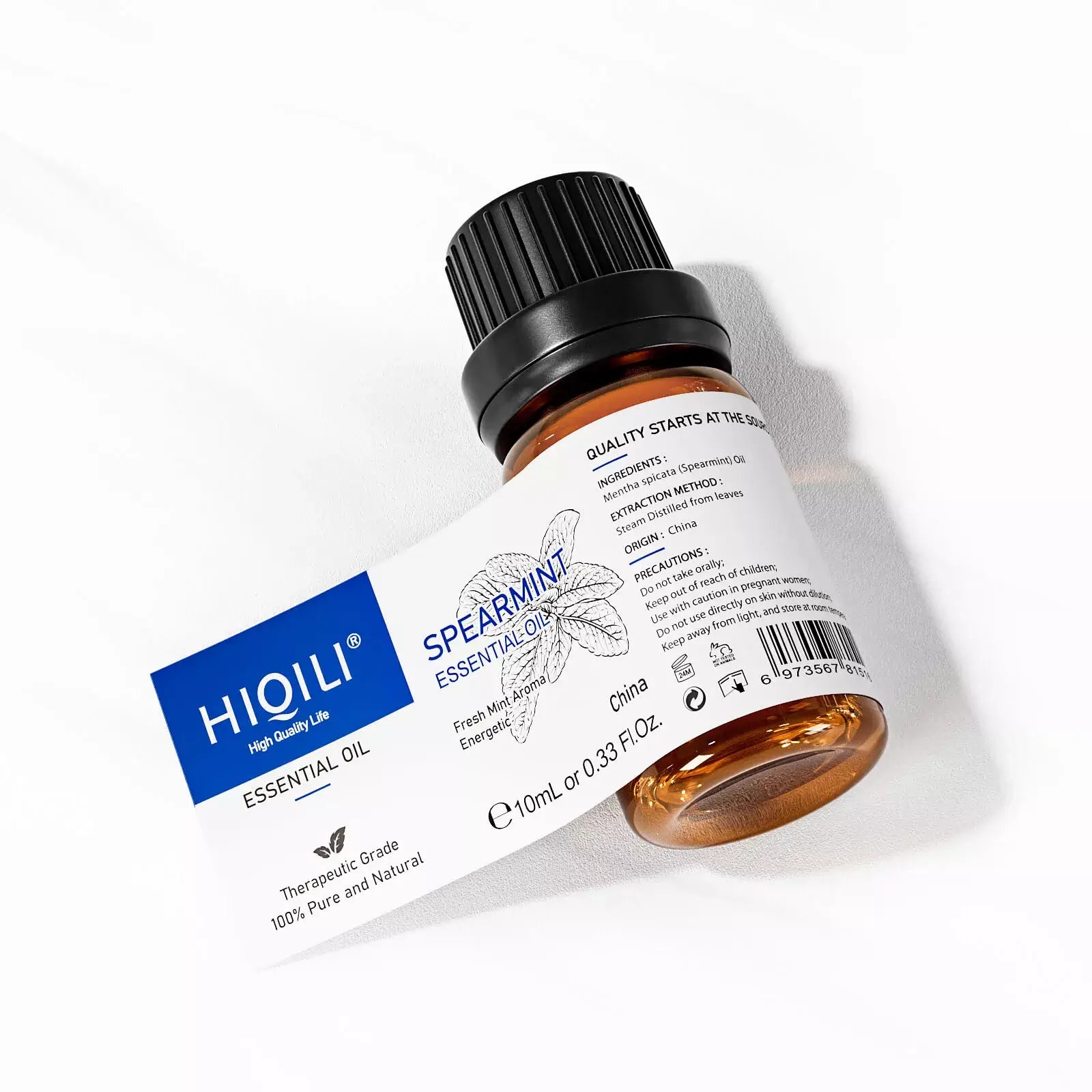
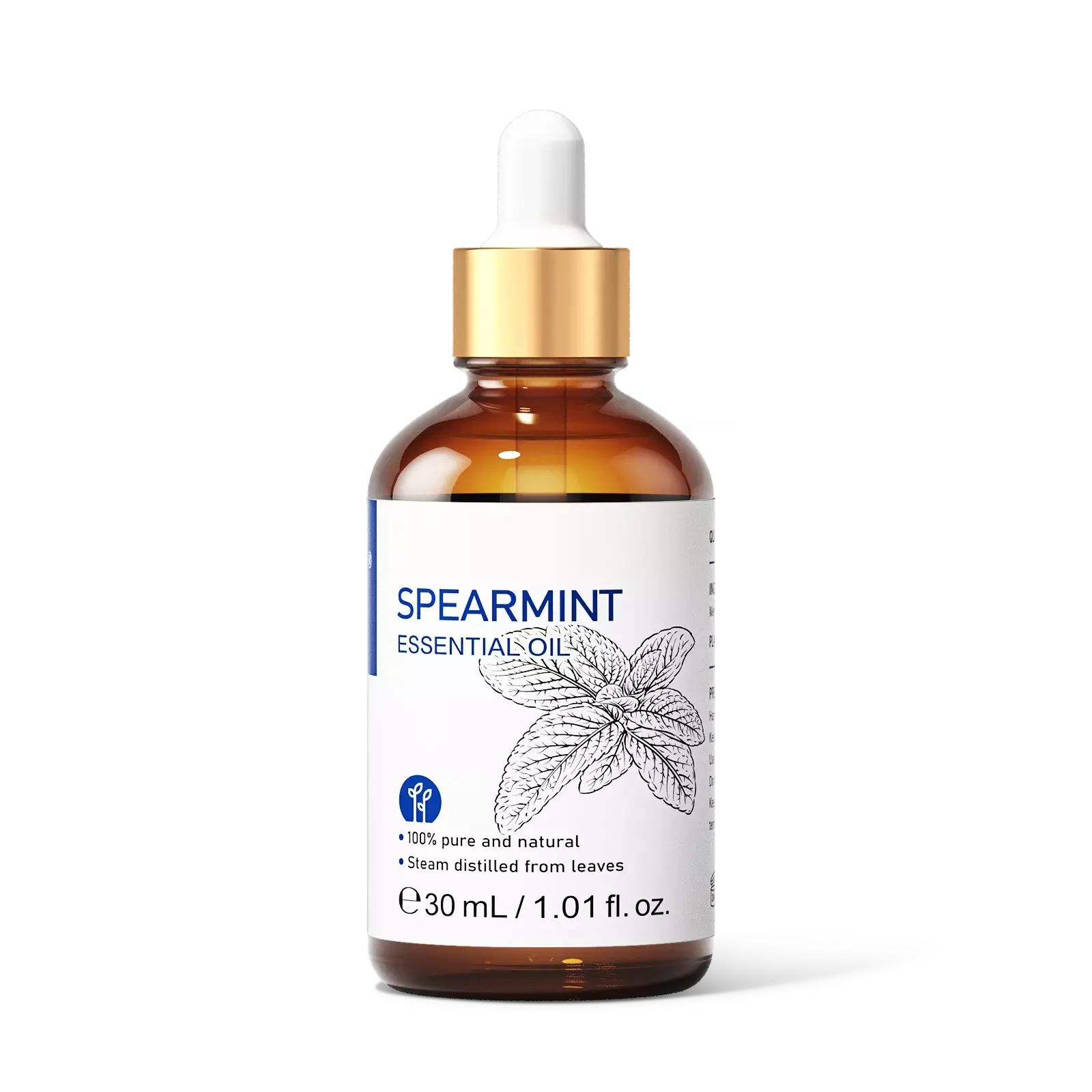
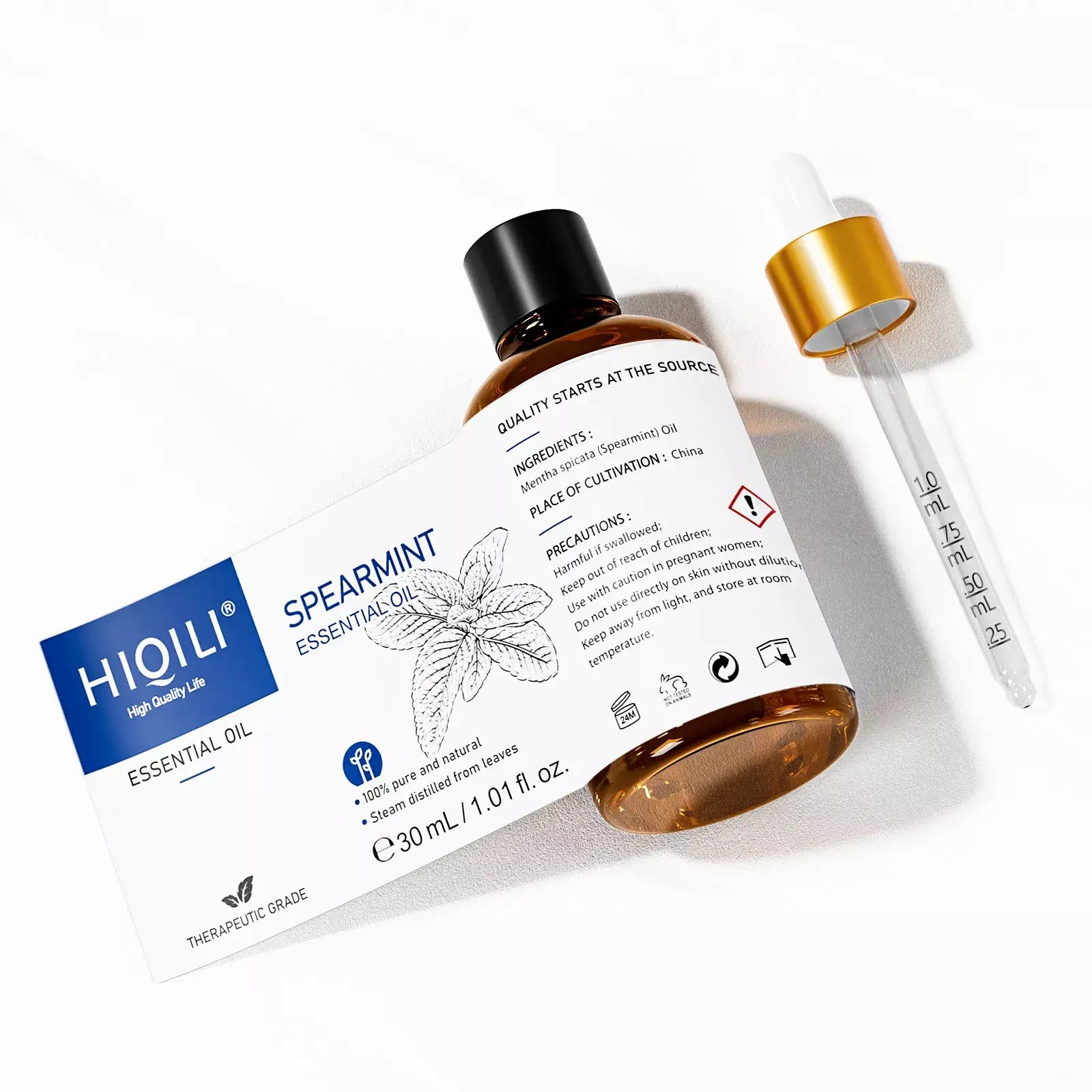

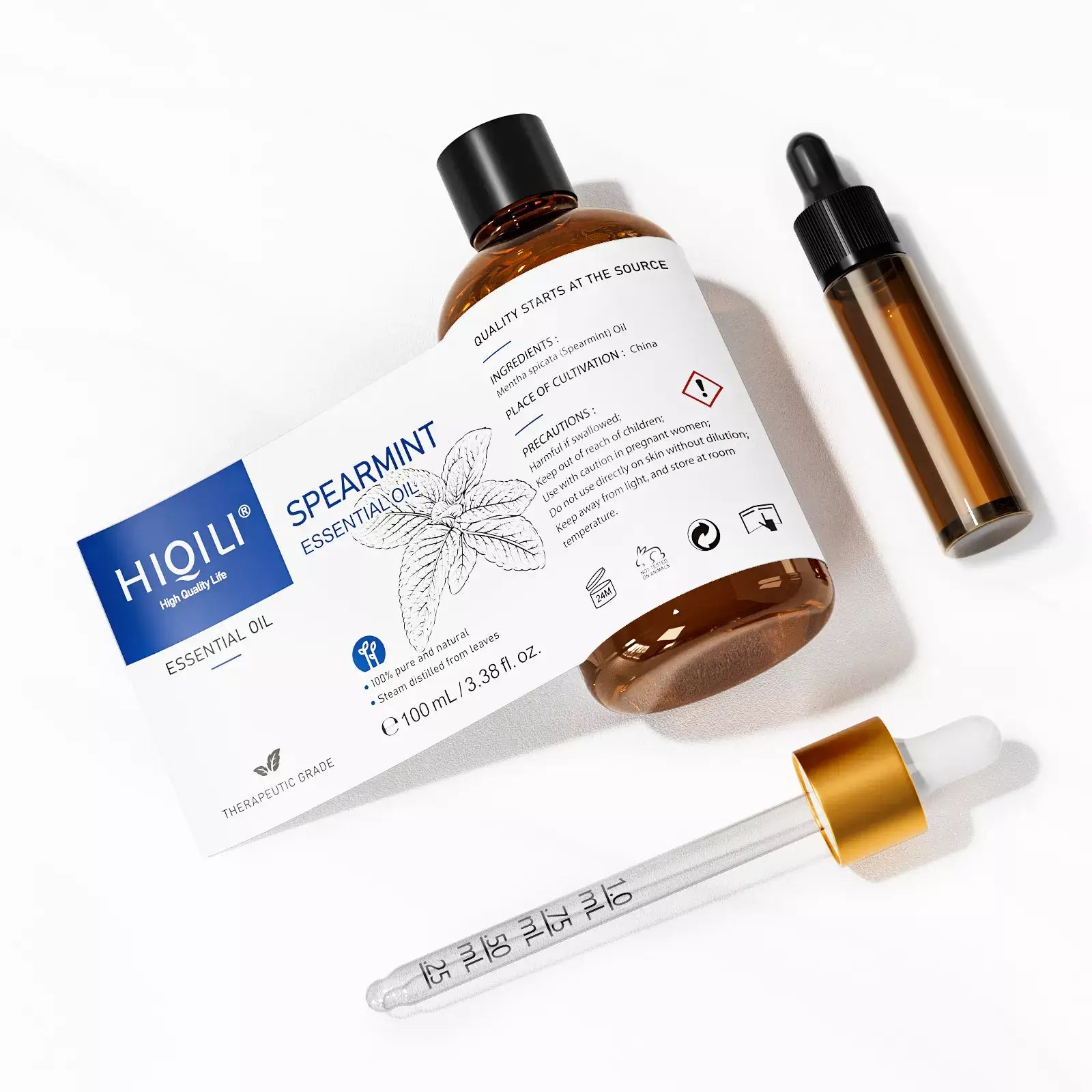

Spearmint Oil
- ✔ 100% Pure Spearmint Essential Oil
- ✔ 7 Days to Significantly Improve PCOS Facial Hirsutism
- ✔ Reduce Facial and Chin Hair Naturally
- ✔ Purchase 100mL and Get a Free 10mL Travel Bottle – Perfect for On-the-Go!
Limited offer: Buy Spearmint Oil and get 20% OFF these products!
Trusted By Thousands to Combat PCOS Hirsutism
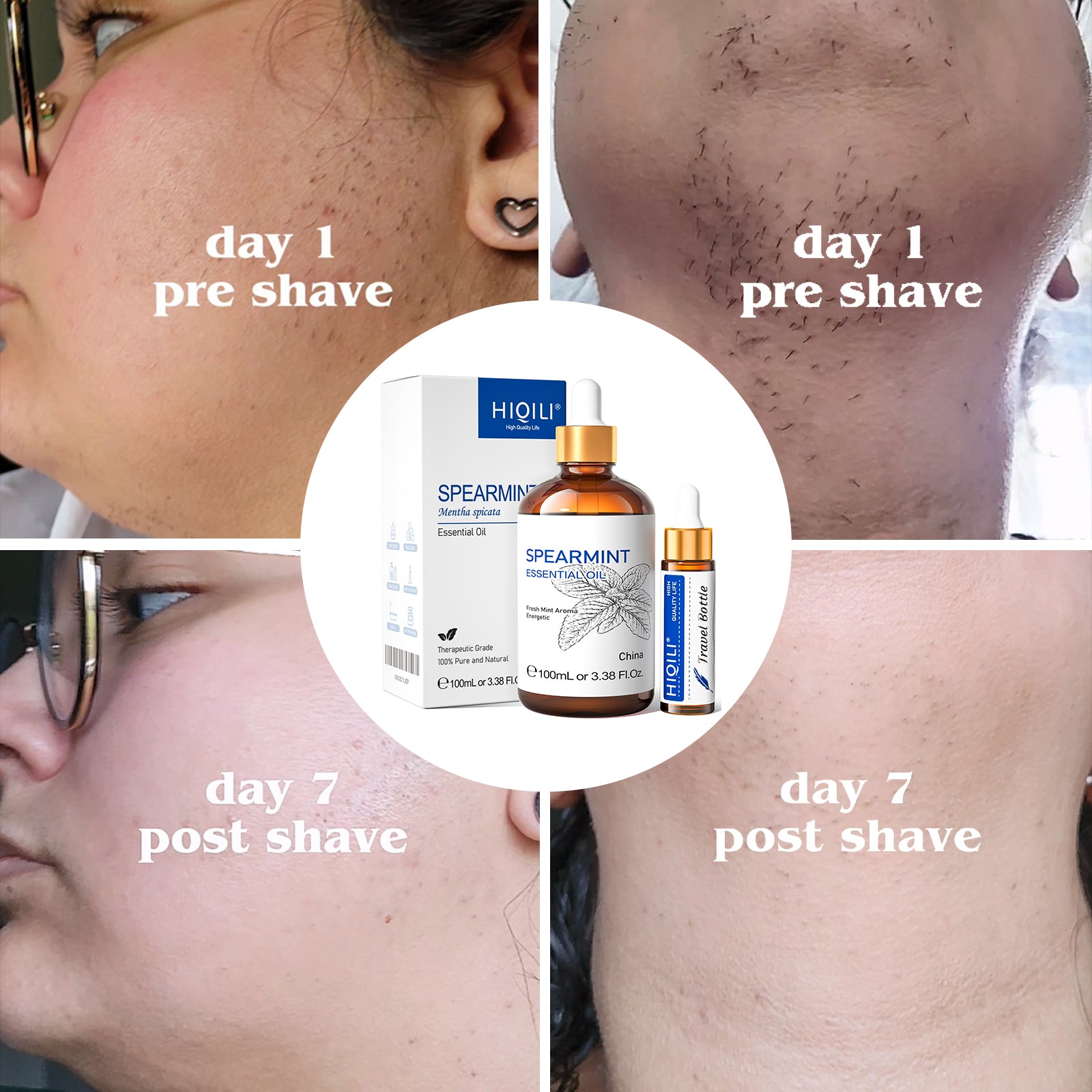
Spearmint Oil for Facial Hair Before And After
Struggling with PCOS-related facial hair? After just one week, Lisa noticed a significant reduction in unwanted facial hair.
How to Use Spearmint Oil for Facial Hair?
The Benefits and Uses of Spearmint Oil for Facial Hair
What is Spearmint Oil?
Spearmint oil is extracted from the spearmint plant (Mentha spicata) by steam distillation. It contains several active compounds, including carvone, limonene and menthol, which are responsible for its therapeutic properties. Unlike peppermint oil, spearmint oil has a milder aroma and is commonly used in aromatherapy, cosmetics and skincare products as a weapon in women's fight against PCOS, and it is its use in combination with jojoba oil on the face is effective in minimizing the growth of hair on the face. In addition, the refreshing aroma of spearmint essential oil relaxes the mind and body, effectively relieving fatigue and lifting the spirit, encouraging people to devote themselves to life and work. Uses of spearmint essential oil include eliminating inflammation and enhancing the function of the digestive organs, as well as preventing bad breath, eliminating headaches, and relieving the symptoms of respiratory diseases. When blending essential oils for topical use, be sure to dilute them well. Our spearmint essential oil for facial hair is steam distilled from the whole spearmint plant.
Benefits of Spearmint Oil for Facial Hair
- Reduction of Unwanted Facial Hair: Spearmint oil is believed to have anti-androgenic properties, which can help reduce the growth of unwanted facial hair, especially in women. Studies suggest that spearmint tea can lower testosterone levels, potentially leading to less facial hair growth.
- Healthier Skin: Spearmint oil possesses antibacterial and anti-inflammatory properties, which can help improve skin health. It can soothe irritated skin, reduce redness, and prevent infections, promoting a healthier environment for facial hair.
- Soothing Effects: The menthol content in spearmint oil provides a cooling sensation, which can be beneficial for soothing the skin after shaving or waxing. This can help reduce post-shave irritation and ingrown hairs.
How to Use Spearmint Oil for Facial Hair
Direct Application:
To use spearmint oil directly on your facial hair, follow these steps:
- Ingredients:
- 2-3 drops of spearmint essential oil
- 1 teaspoon (about 5 ml) of carrier oil (such as jojoba oil, almond oil, or coconut oil)
- Instructions:
- Mix the Oils: In a small bowl or directly in your palm, mix 2-3 drops of spearmint essential oil with 1 teaspoon of your chosen carrier oil. This dilution ensures that the essential oil is safe for your skin and effectively conditions your facial hair.
- Apply to Facial Hair: Gently rub the oil mixture between your hands and apply it to your beard or mustache. Massage it into the hair and skin underneath, making sure to cover the entire area evenly.
- Let It Absorb: Allow the oil to absorb into your facial hair and skin for at least 15-30 minutes. You can also leave it on overnight for deeper conditioning.
- Rinse or Leave In: Depending on your preference, you can rinse your face with warm water after the application or leave the oil in for ongoing conditioning and fragrance throughout the day.
It's not uncommon to experience a slight stinging sensation when using essential oils, especially if they are applied directly to the skin or in higher concentrations. Mixing a few drops with lotion, as you're doing, is a great way to dilute the oil and reduce irritation. Over time, your skin may adjust to the application, and the sensation should lessen.
How Often Should You Use It?
As for frequency, it's generally safe to use essential oils daily when properly diluted. Many people find that applying the spearmint oil mixture once or twice a day works well—preferably at night, so the oil can work its magic without interference from sun exposure or makeup. However, it's always a good idea to monitor your skin's response and adjust usage as needed. If irritation persists, consider reducing the amount used or applying less frequently.
A Few Things to Keep in Mind:
- Skin Sensitivity: Essential oils are highly concentrated and can sometimes cause redness, itching, or even allergic reactions, especially if your skin is sensitive. Doing a patch test before regular use is always a wise step.
- Hormonal Effects: Spearmint oil, in particular, is known to have some impact on hormones such as testosterone and estrogen. While this can be helpful for facial hair concerns, be mindful of any unexpected changes in your cycle, mood, or overall health, and consult with a healthcare professional if you notice anything unusual.
- Medication Interactions: If you’re taking medications—especially those related to hormones or liver function—spearmint oil could potentially interact with them. It’s best to check with your doctor or pharmacist to be safe.
Feel free to reach out if you have any more questions or concerns!
DIY Recipes
Incorporating spearmint oil into DIY facial hair care products can enhance your routine.
- Spearmint Conditioning Oil
- Ingredients:
- 2 tablespoons of argan oil
- 1 tablespoon of sweet almond oil
- 1 tablespoon of jojoba oil
- 10 drops of spearmint essential oil
- Optional: 5 drops of tea tree oil (for added antibacterial properties)
- Instructions:
- Mix the Oils: Combine the argan, almond, and jojoba oils in a small bottle.
- Add Essential Oils: Add 10 drops of spearmint essential oil and, if using, 5 drops of tea tree oil. Shake well to mix the ingredients thoroughly.
- Application: Use a few drops of the conditioning oil daily, massaging it into your facial hair and skin to keep it moisturized, soft, and fresh-smelling.
DIY Spearmint & Sugar Scrub for Unwanted Facial Hair
If you’re looking for a gentle, natural way to support your facial hair care routine, a homemade spearmint and sugar scrub is an easy and effective option. This scrub not only helps manage unwanted facial hair but also leaves your skin feeling refreshed and smooth.
What You’ll Need:
- ½ cup of sugar (either white or brown works well)
- ¼ cup of olive oil
- 10 drops of spearmint essential oil
Step-by-Step Instructions:
- Combine Ingredients: In a small mixing bowl, add the sugar, olive oil, and spearmint essential oil. Stir until the mixture forms a soft, even paste.
- Transfer for Storage: Spoon your finished scrub into a clean, airtight jar so it stays fresh between uses.
How to Apply:
- Take a small amount of the scrub and gently massage it onto damp skin using light, circular motions, especially over areas of concern.
- Focus on massaging for one to two minutes, letting the sugar exfoliate and the spearmint oil work its magic.
- Rinse thoroughly with warm water and pat your skin dry. Use this scrub one to two times per week for best results.
Why This Scrub Works:
- Sugar sloughs off dead skin cells and can help prevent clogged pores, encouraging healthier skin beneath facial hair.
- Olive oil delivers rich hydration and supports your skin’s barrier without leaving a heavy residue.
- Spearmint essential oil not only provides a fresh aroma but may support hormonal balance, complementing your efforts to reduce unwanted facial hair naturally.
Remember to perform a patch test before first use, and always follow with moisturizer or your favorite facial oil blend.
Spearmint and Lavender Oil Blend for Facial Hair
If you’re looking to soothe your skin and address unwanted facial hair with a naturally aromatic approach, a blend of spearmint and lavender essential oils makes for an excellent DIY solution. Both oils are gentle, aromatic, and packed with skin-loving properties.
Ingredients:
- 5 drops spearmint essential oil
- 5 drops lavender essential oil
- 1 ounce (30 ml) of jojoba oil (serves as the carrier)
Instructions:
- In a small, dark glass bottle (to preserve the integrity of the oils), combine the spearmint and lavender essential oils.
- Pour in the jojoba oil and shake gently until well mixed. This ensures even distribution of the essential oils throughout your carrier base.
- After cleansing your face in the evening, use a cotton pad or clean fingertips to apply a small amount of the blend to areas with unwanted facial hair.
- Leave the blend on overnight for best results, or for at least 30 minutes if you prefer to rinse it off.
Lavender adds a calming touch to this recipe, reducing potential irritation while complementing the soothing, invigorating effects of spearmint. This gentle elixir works nightly, helping your skin feel refreshed, soft, and delicately scented.
Spearmint and Green Tea Face Mask Recipe for Facial Hair
For those looking to add another nourishing treatment to your facial hair care routine, consider trying a spearmint and green tea face mask. This mask harnesses the calming, antioxidant-rich properties of green tea alongside the soothing, hormone-balancing potential of spearmint oil to support smoother, fresher skin and may help minimize unwanted facial hair.
What You’ll Need:
- 1 tablespoon high-quality green tea powder (or finely ground green tea leaves)
- 5 drops spearmint essential oil
- 1 tablespoon raw honey
- A splash of water (enough to create a smooth, spreadable paste)
How to Make and Use:
- In a small bowl, combine the green tea powder and honey.
- Add the spearmint essential oil and stir well.
- Slowly add water, a few drops at a time, until the mixture reaches a thick but spreadable consistency.
- Apply the mask evenly to clean skin, especially targeting areas with unwanted facial hair.
- Allow the mask to sit for 15–20 minutes.
- Rinse gently with warm water and pat dry.
For the best results, use this mask two or three times per week.
Why This Works:
- Green tea floods the skin with antioxidants, helping to calm irritation and defend against environmental stressors.
- Spearmint oil may help support hormone balance for those seeking to reduce facial hair growth.
- Honey naturally soothes and hydrates while keeping skin clear and healthy.
Incorporating this gentle, herbal face mask into your weekly regimen can support both the appearance and health of your skin as it complements the use of direct spearmint oil applications and conditioning treatments.
Properties
Country
Plant part
Cultivation
Chemical families
Botanical families
Extraction method
Therapeutic & Aromatic Properties
Therapeutic properties
Notes
Aromas
What to Expect: Realistic Results and Limitations of Spearmint Oil & Tea
While spearmint oil and spearmint tea have become popular among women looking to manage unwanted facial hair—especially those affected by PCOS—it's important to approach these natural remedies with balanced expectations.
Results Vary Person to Person
Although many users, like Lisa and our TikTok community, have reported smoother skin or finer hair growth after adding spearmint to their daily regime, results are not guaranteed for everyone. Genetics, hormone levels, and individual health differences mean that what works for one person may not work for another. Some women notice a visible reduction in facial hair after a few weeks, while others experience more subtle changes or none at all.
Managing Expectations
- Spearmint is a Complement, Not a Cure: Drinking spearmint tea or applying spearmint oil topically may help lower androgen levels, which can slow hair growth over time—but this is typically gradual and modest, not an overnight transformation.
- Consistency Matters: For any effects to become noticeable, regular use (daily or several times a week) over several weeks is usually necessary.
- Not a Substitute for Medical Advice: While spearmint is considered safe for most, it shouldn't replace guidance from a healthcare provider, especially for those with diagnosed hormonal disorders or on medication.
Possible Limitations
- Mild to Moderate Effects: Spearmint may help reduce the thickness or rate of hair growth, but is unlikely to make coarse or dense facial hair disappear completely, especially in cases of severe hirsutism.
- Potential Sensitivities: Always dilute spearmint essential oil properly and patch-test before applying to your skin, as some individuals may experience irritation or allergic reactions.
In Summary
Consider spearmint oil and tea as gentle, supportive tools in your overall skincare and wellness routine, not as miracle solutions. Be patient with the process, and celebrate the small wins—like softer skin or fewer ingrown hairs—while exploring what works best for your unique needs and lifestyle.

10mL Travel Bottle with Dropper
For easy portability! A free 10mL travel bottle is only included with the 100mL purchase.
Frequently Asked Questions
Is Spearmint Oil Safe for Dogs?
Spearmint oil can be safe for dogs when used in moderation and properly diluted. However, it’s essential to consult with your veterinarian before using spearmint essential oil on or around your dog. Some dogs might be sensitive to essential oils, and concentrated spearmint oil can lead to irritation or even toxicity. Always ensure that the oil is properly diluted in a carrier oil and avoid applying it directly to your pet's skin or fur. Inhaling the oil in a well-ventilated area is typically safer than topical application. Always prioritize your pet's health by getting professional advice.
Is Spearmint Essential Oil Safe for Cats?
No, spearmint essential oil is not recommended for use on cats. Cats are highly sensitive to essential oils, and spearmint oil can cause respiratory distress, skin irritation, or even poisoning when ingested or absorbed. Unlike dogs, cats lack certain enzymes that help metabolize essential oils safely. If you want to use spearmint oil around cats, ensure that the area is well-ventilated and that the oil is not directly applied to their fur or skin. Always consult with a veterinarian before using any essential oils in a home with cats.
Does Spearmint Oil Stop Facial Hair Growth?
Yes, spearmint oil may help with facial hair growth, particularly for those dealing with hormonal imbalances. Spearmint oil is often suggested for its potential to balance hormones by lowering testosterone levels, which could potentially promote the growth of facial hair in women with conditions like polycystic ovary syndrome (PCOS). It may also enhance blood flow to the skin, encouraging healthier hair follicles. However, it's important to note that results can vary, and using spearmint oil should be part of a holistic approach that includes proper skincare and health management.
How to Use Spearmint Oil for Facial Hair?
To use spearmint oil for facial hair, dilute the oil with a carrier oil (like jojoba or coconut oil) to avoid irritation. Mix a few drops of spearmint oil with 1 tablespoon of your carrier oil. Apply this mixture gently to the areas where you desire hair growth, massaging it into the skin for a few minutes to improve blood circulation. It’s important to patch-test any oil on a small area of skin before full application to ensure there is no allergic reaction. For optimal results, use spearmint oil regularly and combine it with a healthy skincare routine to maximize its potential benefits for facial hair growth.
Where to Buy Spearmint Oil?
You can buy spearmint oil from HIQILI through their official website or through trusted online retailers like Amazon. HIQILI is known for offering high-quality essential oils, including spearmint, that are sourced and produced with care. If you prefer purchasing directly, visit the HIQILI website to explore their range of essential oils, including their spearmint oil, which is popular for its refreshing and uplifting scent.
How Do You Make Spearmint Oil?
Making spearmint oil at home is possible through a simple distillation process. Here’s how you can make it:
- Harvest fresh spearmint leaves. Ensure they are free of pesticides or contaminants.
- Prepare a carrier oil. Use oils like jojoba or coconut oil as a base.
- Place the mint leaves in a jar and cover them with your carrier oil.
- Seal the jar and let the mixture sit in a warm, sunny spot for about 2 weeks, shaking it daily.
- Strain the oil through a fine mesh or cheesecloth to remove the mint leaves, leaving you with homemade spearmint-infused oil.
Alternatively, you can use a distillation kit, where steam is passed through the plant material to extract the essential oil, though this is more advanced. Homemade spearmint oil is great for personal use, but purchasing from a reputable supplier is best for consistent purity and strength.
What is Spearmint Essential Oil Good for in a Diffuser?
Spearmint essential oil is great for use in a diffuser as it helps freshen up the air, promote mental clarity, and uplift the mood. Its refreshing, minty aroma can help to relieve stress, alleviate headaches, and provide an energy boost. Additionally, spearmint oil is known for its ability to improve concentration and focus, making it perfect for use in workspaces or study areas. It also has antibacterial properties that can cleanse the air, making your home feel fresher and cleaner.
Is Spearmint Oil Toxic?
Spearmint oil is generally considered safe when used properly and in moderation. However, concentrated spearmint oil can be toxic if ingested or applied directly to the skin without dilution. If swallowed in large amounts, spearmint oil may cause nausea, vomiting, or other gastrointestinal issues. It is also not safe for pets, especially cats, who are highly sensitive to essential oils. Always ensure proper dilution when using spearmint oil on the skin, and avoid ingestion unless under professional guidance. For safety, use spearmint oil only as directed and consult a healthcare professional for any concerns.
Can Pregnant Women Be Around Spearmint Essential Oil Aromatherapy?
Pregnant women should exercise caution when using spearmint essential oil, especially in aromatherapy. While some essential oils are considered safe for pregnant women, spearmint oil can have stimulating effects, which may not be ideal during pregnancy. It is best to avoid direct contact with spearmint oil or use it in a diffuser in moderation. Always consult with a healthcare provider before using any essential oils during pregnancy to ensure safety for both the mother and baby.
Is Spearmint Essential Oil Safe for Babies?
Spearmint essential oil is not recommended for use around babies. Babies have sensitive skin and respiratory systems, and spearmint oil, like other essential oils, may cause irritation or breathing difficulties. It’s best to avoid using spearmint oil in any form for babies under 2 years old. If you need to use an essential oil for babies, consider oils like lavender or chamomile, which are generally considered safer. Always consult with a pediatrician before introducing any essential oils to babies, especially in a diffuser or as part of a skincare routine.
How Spearmint Supports Women with PCOS?
You may be wondering why so many women battling PCOS facial hair are turning to spearmint oil. The answer lies in spearmint’s unique ability to naturally balance hormones linked to excess hair growth.
PCOS (polycystic ovary syndrome) often brings along a stubborn duo: elevated androgen levels and pesky symptoms like unwanted facial hair, irregular cycles, and acne. While traditional treatments can help, many look to botanical support—and that’s where spearmint shines.
Recent studies (like those from researchers at Ain Shams University and the National Institute for Research in Reproductive Health) have shown that consuming spearmint tea twice daily can lower testosterone levels while gently supporting the hormones that need a boost (LH and FSH). This balancing act helps dial down the excess androgens that contribute to facial and chin hair.
Whether you opt for the soothing ritual of spearmint tea or the targeted power of spearmint essential oil blends, this humble herb offers a gentle, plant-powered way to help manage one of the trickiest PCOS symptoms.
Why Consultation with a Healthcare Professional Matters?
Before you start adding spearmint oil to your daily routine—especially if you’re managing conditions like PCOS, are expecting, nursing, or already taking medication—it’s wise to have a quick chat with your doctor or a qualified healthcare provider. Here’s why:
- Personalized Guidance: Everyone’s body chemistry is unique, and what works wonders for one person might cause issues for another. A healthcare professional can help assess whether spearmint oil is right for your particular situation.
- Medication Interactions: Essential oils like spearmint can sometimes interact with prescription drugs or supplements. Discussing your plans with your provider helps you avoid any unwanted surprises.
- Safety First: For those who are pregnant, breastfeeding, or living with chronic health issues, a professional can identify any risks and recommend proper dosages and application methods to ensure you’re using spearmint oil safely.
- Addressing Allergies and Sensitivities: Your provider can help you spot any potential for allergic reactions, especially when applying oils to delicate facial skin.
Choosing to consult with a healthcare professional isn’t just about checking a box—it’s about making sure your path to less facial hair and healthier skin is both safe and effective.
How Might Spearmint Oil Interact With Medications or Health Conditions?
While spearmint oil is enjoyed for its fresh scent and potential wellness perks, there are some important considerations if you’re managing health conditions or using medication. Spearmint oil contains naturally occurring compounds that may impact how medications work in your body. For example, it can influence enzymes in the liver responsible for processing certain drugs, which might change how effective these medications are or increase the risk of side effects.
If you’re taking medications related to hormone balance or liver function, such as those prescribed for PCOS or other chronic conditions, spearmint oil could potentially interact with your treatment plan. People with sensitive health situations—like being pregnant, breastfeeding, or experiencing liver issues—should be especially cautious.
Always check in with your healthcare provider before introducing spearmint oil into your routine, particularly if you’re on medication or have ongoing health concerns. This helps ensure you can enjoy the benefits of spearmint oil safely, without interfering with your current treatments or overall wellbeing.
If you have any questions, you are always welcome to contact us. We'll get back to you as soon as possible, within 24 hours on weekdays.
-
Shipping Information
Use this text to answer questions in as much detail as possible for your customers.
-
Customer Support
Use this text to answer questions in as much detail as possible for your customers.
-
FAQ’s
Use this text to answer questions in as much detail as possible for your customers.
-
Contact Us
Use this text to answer questions in as much detail as possible for your customers.








































